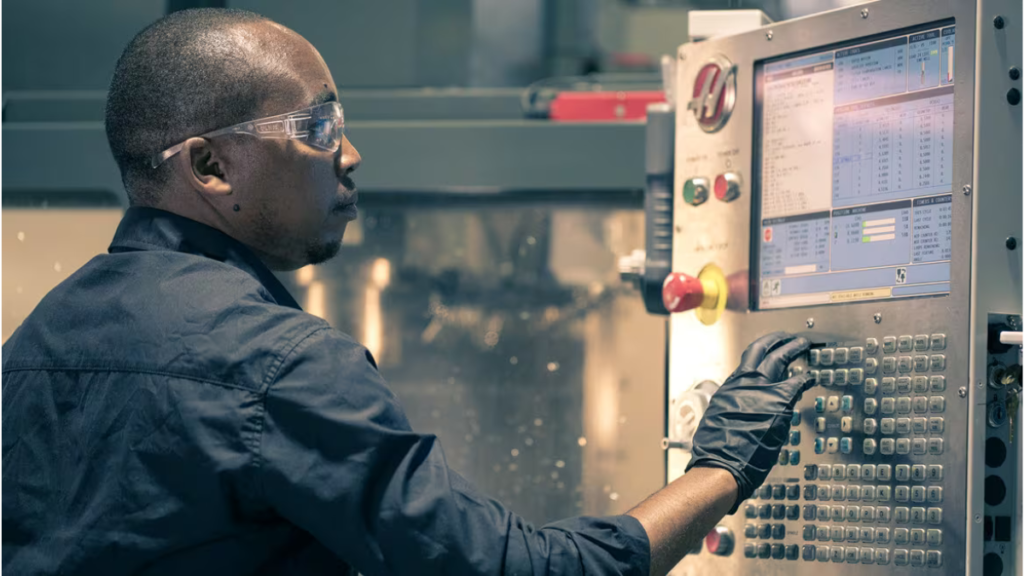CNC programming is a crucial aspect of modern manufacturing, enabling the creation of intricate parts with unparalleled accuracy. It involves translating design specifications into machine-readable instructions, enabling machines to operate with precision. G and M codes, the building blocks of CNC programming, dictate toolpaths, speeds, and other parameters. Mastery of these codes is essential for machinist communication with the machine.
CNC programmin’g software plays a pivotal role in the process, with CAD/CAM software facilitating the creation of 3D models and CAM translating these models into CNC code. Post-processing software converts CAM-generated toolpaths into machine-specific G-code, ensuring compatibility and optimal performance.
Advanced CNC programmin’g techniques include parametric programming, which introduces flexibility by incorporating variables, and high-speed machining (HSM), which optimizes toolpaths and cutting speeds without compromising precision. Thorough planning and simulation are essential for executing a CNC program, while detailed documentation and version control ensure consistency and traceability.
The future of CNC programmin’g is promising, with the integration of Artificial Intelligence (AI) and Industry 4.0 principles propelling it into new frontiers. Mastering CNC programmin’g not only commands the language of machines but also unlocks the door to a future where precision and efficiency seamlessly converge.
I. Fundamentals of CNC Programming
1.1 Understanding CNC Machines
CNC machines, ranging from milling machines to lathes, operate based on coded instructions. These machines interpret CNC programs, which consist of a series of commands that guide the tool’s movement and operation. G and M codes, the building blocks of CNC programming, define toolpaths, speeds, and other crucial parameters.
1.2 G and M Codes: The Language of CNC
G codes dictate the motion and position of the tool, specifying operations like cutting, drilling, or milling. M codes, on the other hand, control auxiliary functions such as tool changes or coolant flow. Mastery of these codes is fundamental to CNC programming, as they form the vocabulary through which the machinist communicates with the machine.
II. CNC Programming Software
2.1 CAD/CAM Integration
Computer-Aided Design (CAD) and Computer-Aided Manufacturing (CAM) software play pivotal roles in CNC programming. CAD facilitates the creation of 3D models, while CAM translates these models into CNC code. Seamless integration between CAD and CAM streamlines the programming process, ensuring accuracy in both design and execution.
2.2 Post-Processing: Bridging the Gap
Post-processing software converts CAM-generated toolpaths into machine-specific G-code. This step is crucial for adapting the program to the unique characteristics of the CNC machine in use. As CNC machines vary in design and functionality, post-processing ensures compatibility and optimal performance.
III. Advanced CNC Programming Techniques
3.1 Parametric Programming
Parametric programming introduces flexibility into CNC programs by incorporating variables. Instead of static values, parameters represent dimensions or variables that can be modified easily. This dynamic approach enhances efficiency, allowing for rapid adjustments without rewriting the entire program.
3.2 High-Speed Machining (HSM)
High-speed machining optimizes toolpaths and cutting speeds to maximize efficiency without compromising precision. By strategically managing cutting forces and tool engagement, HSM reduces machining time and extends tool life. This technique is especially valuable in industries where time is a critical factor.
IV. CNC Programming Best Practices
4.1 Thorough Planning and Simulation
Before executing a CNC program, thorough planning and simulation are essential. Simulation software allows machinists to visualize toolpaths and detect potential issues, minimizing the risk of errors during actual machining. This proactive approach enhances both safety and efficiency.
4.2 Documentation and Version Control
Maintaining detailed documentation of CNC programs is crucial for consistency and traceability. Version control systems help manage program revisions, ensuring that the latest and most accurate version is always in use. This practice minimizes the risk of using outdated or incorrect programs.
V. The Future of CNC Programming
5.1 Integration of Artificial Intelligence
The integration of Artificial Intelligence (AI) in CNC programming holds the promise of further automation and optimization. AI algorithms can analyze vast datasets to optimize toolpaths, speeds, and feeds, leading to enhanced efficiency and reduced machining times. This intersection of AI and CNC programmin’g represents a frontier for innovation in the manufacturing industry.
5.2 Embracing Industry 4.0
As manufacturing embraces the principles of Industry 4.0, CNC programming is evolving to become a key player in smart, interconnected factories. Real-time data exchange between machines, sensors, and CNC systems allows for adaptive manufacturing processes, where CNC programs can dynamically adjust based on changing conditions, further increasing efficiency and responsiveness.
Conclusion: Mastering the Art and Science of CNC Programming
In the realm of modern manufacturing, CNC programming stands as a cornerstone, enabling the creation of intricate components with unparalleled precision and efficiency. From the fundamental G and M codes to advanced techniques like parametric programming and high-speed machining, CNC programmin’g is a dynamic field that continues to evolve.
As technology advances, the integration of AI and the principles of Industry 4.0 are set to propel CNC programmin’g into new frontiers. Embracing these innovations will be key for manufacturers seeking to stay ahead in an ever-changing landscape. In mastering CNC programming, one not only commands the language of machines but also unlocks the door to a future where precision and efficiency seamlessly converge.







